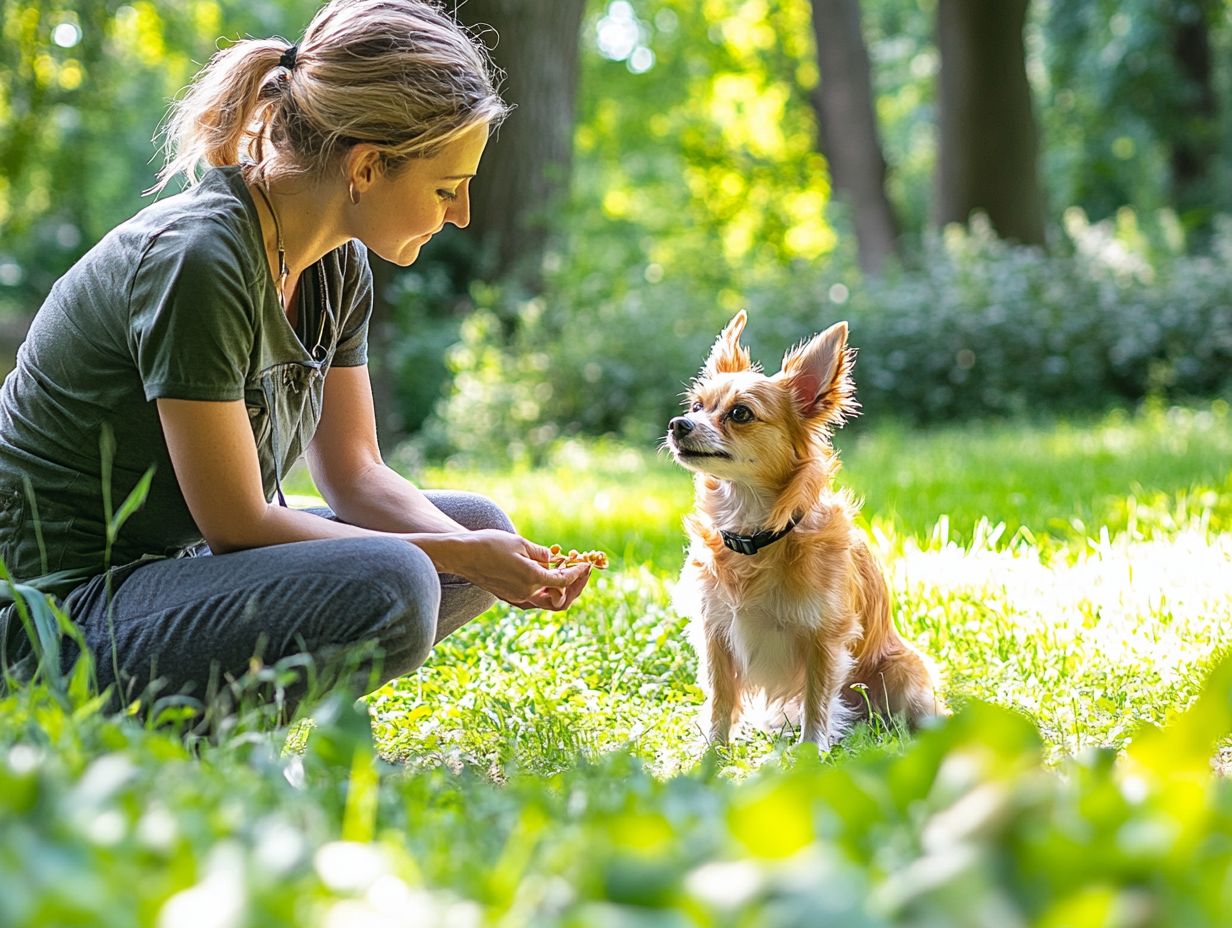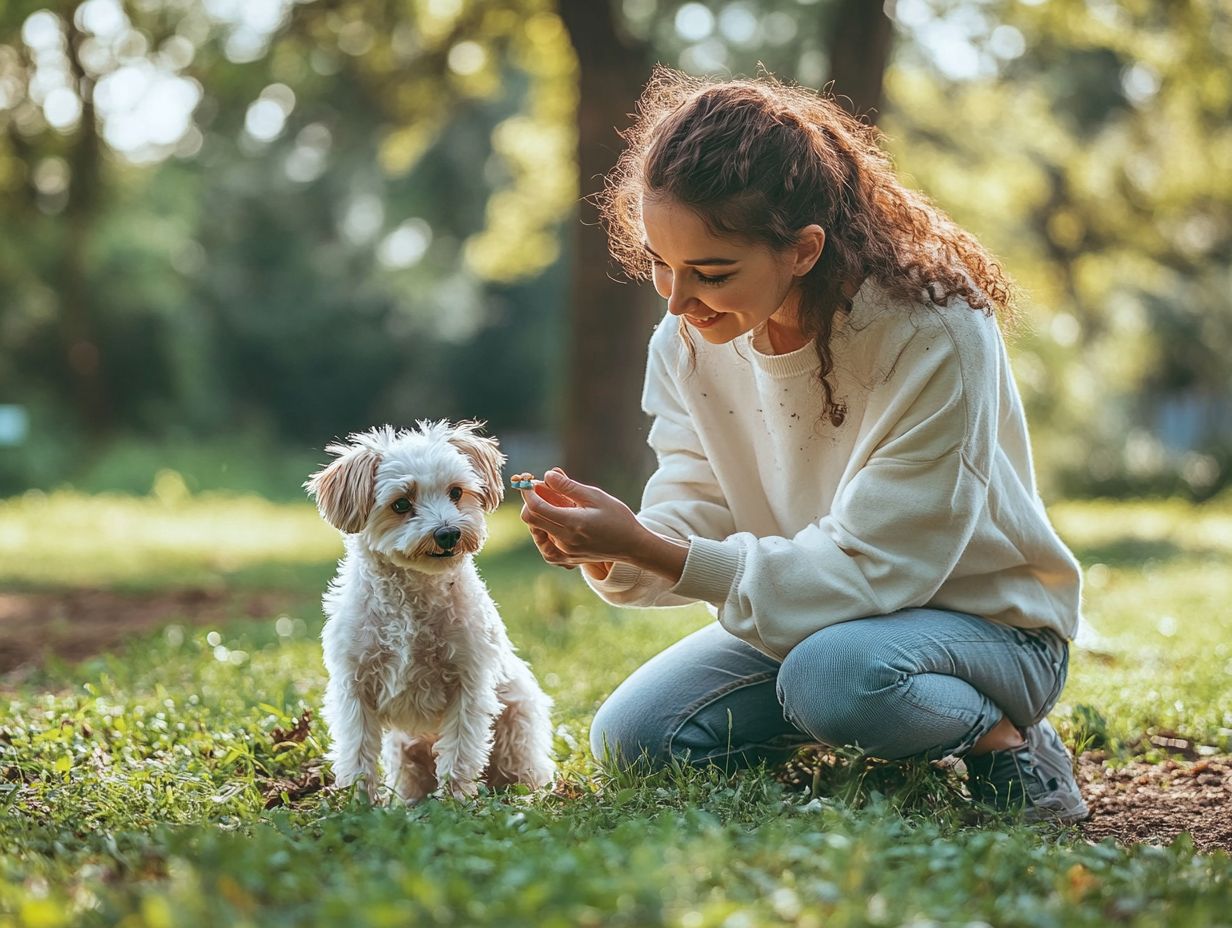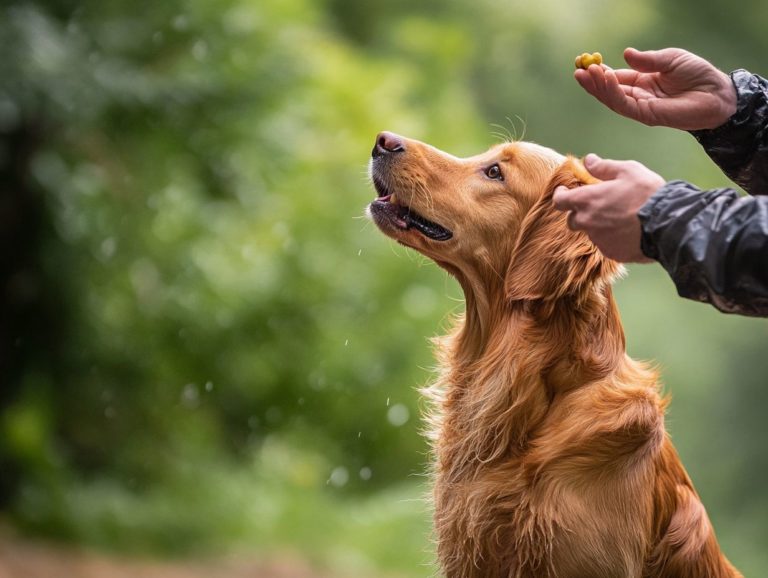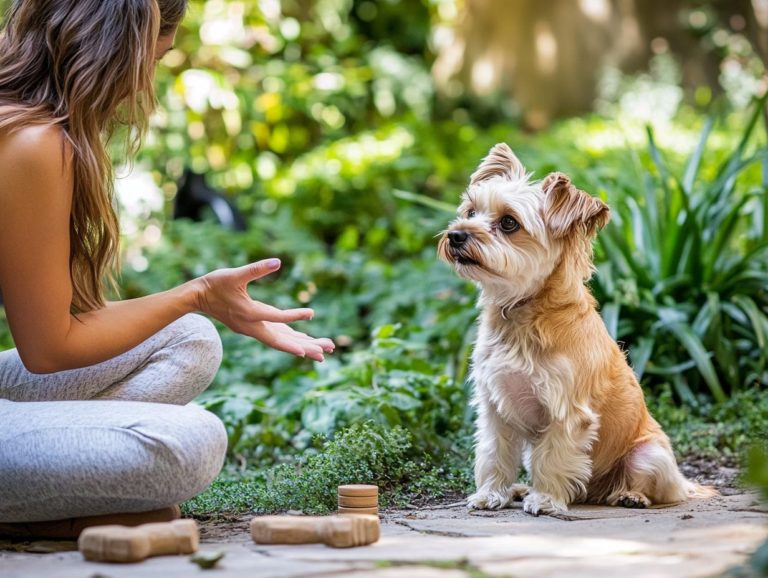Best Practices for Training Fearful Dogs
Understanding and addressing the fears of your canine companion can be both rewarding and challenging. Many dogs experience anxiety due to past traumas, lack of socialization, or specific triggers.
This exploration delves into the causes of fear and anxiety in dogs, guiding you on how to recognize their signs and implement effective strategies to create a safe training environment.
It emphasizes the importance of building trust, tackling specific phobias, and maintaining progress, ensuring that you and your dog can thrive together in harmony.
Contents
- Key Takeaways:
- Understanding Fearful Dogs
- Creating a Safe Environment for Training
- Building Trust with Your Dog
- Addressing Specific Fears and Phobias
- Maintaining Progress and Continued Training
- Frequently Asked Questions
- Curious about training fearful dogs? What are the best practices for training fearful dogs?
- How can I use positive reinforcement to train my fearful dog?
- Why is patience important when training a fearful dog?
- What role does consistency play in training a fearful dog?
- How can I create a safe and comfortable environment for my fearful dog?
- What should I avoid when training a fearful dog?
Key Takeaways:

- Understand what causes fear and anxiety in fearful dogs to better manage it during training.
- Create a safe training environment by minimizing triggers and using positive reinforcement techniques.
- Building trust and a strong bond with your dog is crucial for overcoming fear and boosting confidence.
Understanding Fearful Dogs
It’s important for pet owners and trainers to understand fearful dogs. These canines often show a range of anxiety signs that can hinder their ability to interact with their environment.
By understanding their feelings and recognizing early warning signs, you can support your pets better and cultivate a more harmonious living atmosphere.
It s vital to appreciate how dogs show their feelings and identify common fear triggers that may provoke distress in them. This foundational knowledge empowers you to nurture your fearful dogs effectively and develop a deeper bond with them.
Causes of Fear and Anxiety in Dogs
Fear and anxiety in dogs can come from various sources. These include inadequate socialization during their early years, traumatic incidents, or even genetic tendencies.
For example, loud noises like fireworks or thunderstorms can trigger panic, while sudden movements from people or objects can make them feel threatened. Unfamiliar environments, such as bustling streets or crowded areas, can also overwhelm these sensitive creatures.
To help your furry friend cope, turn to positive reinforcement training. Gradually introduce them to stressors in a controlled way to build their confidence. Establishing consistent routines can provide a reassuring sense of security.
If challenges persist, consult a veterinary behaviorist like Dr. Pamela J. Perry or Kiki Yablon from the Animal Behavior Clinic. They can offer tailored strategies to meet your dog’s unique needs.
Recognizing Signs of Fear in Dogs
Recognizing the signs of fear in dogs is crucial for effective behavior modification and preventing escalation of anxiety-related issues.
When your dog displays behaviors like cowering, tucking its tail, or trying to avoid human interaction, it signals distress. You might also notice signs such as pinned-back ears, heavy panting, or excessive lip licking.
Stay alert for early warning signs like a stiff body posture or avoidance of eye contact. These subtle cues can indicate an emerging fear response. By understanding your dog’s emotional state, you can easily adjust your training to create a more serene environment that fosters confidence and alleviates anxiety, ultimately strengthening the bond between you and your canine companion.
Creating a Safe Environment for Training
Creating a secure environment for training is essential when working with fearful or anxious dogs. This structured setting fosters trust and encourages positive reinforcement, allowing dogs to feel safe and gradually build confidence. For effective approaches, consider the best training methods for rescue pets.
In such an atmosphere, you can effectively implement reward-based training techniques. This helps your dog associate new experiences with positive outcomes. This foundational approach is key to successful training sessions and long-term behavior improvement.
Don t wait start creating a safe space for your dog right now to see quick improvements!
Minimizing Triggers and Stressors

Minimizing fear triggers and stressors is essential for cultivating a nurturing training environment for your fearful dog, especially when considering tips for training an anxious dog in public.
By taking practical steps, you can significantly enhance your pet’s comfort while fostering a sense of security. Limit exposure to loud noises and chaotic situations. This includes bustling streets or crowded events that can escalate anxiety.
Creating a serene home atmosphere with designated quiet spaces can be very effective.
Along with these measures, integrating coping strategies like positive reinforcement during training sessions can help build your dog’s confidence. It’s vital to prioritize socialization in controlled settings, allowing your dog to gradually acclimate to various situations and experiences, ultimately promoting more balanced behavior.
Positive Reinforcement Training Techniques
Positive reinforcement training techniques for training anxious senior pets are invaluable for helping fearful dogs navigate their anxieties and gradually build confidence.
By incorporating rewards like treats, praise, and play, you can cultivate a nurturing environment that encourages your canine companion to venture into new situations without trepidation. For example, when introducing your dog to an unfamiliar environment, using high-value treats can entice them into a more relaxed state, allowing them to form positive associations with what once felt stressful.
Praise amplifies this process, providing immediate feedback and reinforcing courageous behavior. Playtime can motivate your dog and make training enjoyable, transforming sessions into delightful experiences filled with fun.
Gradually exposing your dog to anxiety-inducing stimuli while providing rewards can be effectively guided by a skilled dog trainer in training classes. They can tailor techniques to meet your dog’s unique needs.
Building Trust with Your Dog
Building trust with your dog is an essential step in alleviating fear and anxiety. It cultivates a robust bond and facilitates effective communication rooted in understanding their emotional state.
When you recognize your dog’s body language, you can create positive associations that provide reassurance in various situations. Building trust deepens your bond with your dog and lays the groundwork for successful behavior modification strategies.
Establishing a Strong Bond
Establishing a strong bond with your dog requires a consistent approach rooted in trust, patience, and a keen understanding of their emotional state.
Engaging in playful activities like fetch or tug-of-war stimulates their mind and fosters a genuine sense of companionship. Training sessions provide invaluable opportunities to teach commands while simultaneously building mutual respect.
Shared experiences whether it s a leisurely walk in the park or exploring new trails create meaningful moments that deepen your connection.
When faced with anxiety-inducing situations, it’s essential to maintain a secure environment. Creating safe spaces or employing calming techniques can significantly alleviate stress for both you and your furry friend.
By nurturing these interactions, you can cultivate a harmonious relationship that truly thrives and implement effective training tips for better outcomes.
Building Confidence in Your Dog
Building confidence in your dog is entirely within your reach, thanks to positive associations and tailored training strategies that cater to their unique needs.
Find your dog s specific fears today to help them overcome challenges! By pinpointing fears like unfamiliar noises or new environments you can design gradual exposure exercises. These allow your dog to face challenges in a safe and controlled manner.
If your dog is skittish around loud sounds, start with a gentle introduction at a low volume, pairing it with treats and praise to transform the experience into something positive.
Observe and interpret your dog s body language during these exercises to gauge their comfort level. Celebrate small victories, such as when they calmly respond to a sound or venture into a new space. Each moment reinforces their confidence and paves the way for further progress.
Addressing Specific Fears and Phobias

Addressing specific fears and phobias in dogs is crucial for enhancing their quality of life. This is especially important when navigating challenges like separation anxiety or fear of particular objects or environments through effective coping strategies.
By tackling these issues head-on, you create a more harmonious and fulfilling experience for both you and your canine companion.
Desensitization and Counterconditioning
Desensitization and counterconditioning are powerful training methods that help fearful dogs gradually acclimate to their specific fears. For those looking for training techniques specifically for anxious breeds, embracing these methods can cultivate a structured environment where your canine companion feels safe and supported.
Desensitization involves gently introducing your dog to their fear triggers in a controlled manner. Start from a distance or intensity that won t provoke anxiety. Counterconditioning pairs these triggers with positive experiences like treats or toys to encourage a shift in their emotional response. For example, if your dog is terrified of thunderstorms, play recordings of thunder at a low volume while they enjoy their favorite snacks. Gradually increase the sound’s intensity over time.
A professional dog trainer can enhance your efforts. They can offer personalized strategies and support, ensuring each session is tailored to meet your dog s unique needs.
Dealing with Separation Anxiety
Dealing with separation anxiety in fearful dogs requires a nuanced understanding of their emotional landscape and effective strategies to build trust.
Recognize signs such as excessive barking, destructive behavior, or attempts to escape when left alone. These behaviors can lead to a cycle of stress that impacts both you and your dog, often resulting in feelings of guilt or frustration.
To mitigate these issues, employ gradual desensitization techniques. Start with short absences and slowly extend the duration as your dog becomes more comfortable. Encourage positive experiences during these separations to reinforce desirable behaviors. Providing toys or creating safe spaces can cater to their emotional needs when you’re apart.
Maintaining Progress and Continued Training
Maintaining progress with fearful dogs demands your unwavering consistency and patience. Ongoing training is essential for reinforcing positive behaviors and avoiding setbacks.
Each interaction is an opportunity to build trust and confidence, ensuring your canine companion thrives on this journey.
Consistency and Patience
Consistency and patience are key elements in the training process. For fearful dogs, using methods like clicker training for anxious dogs may require extra time to acclimate to new situations and commands.
Establishing a daily routine is crucial. This creates a structured environment that fosters security and trust. Keep your training sessions short but frequent, concentrating on one behavior at a time.
By employing positive reinforcement, celebrate those small victories, gradually building your dog’s confidence. Incorporating calming cues like deep breathing or brief breaks enhances emotional stability for both you and your canine companion.
Training can be an exciting adventure for you and your dog! By following these steps, the training experience transforms into a shared journey, allowing both of you to savor the learning process while ensuring steady progress at a comfortable pace.
Start working on these techniques today for a happier, more confident dog!
Seeking Professional Help if Needed

Seeking professional help is crucial for pet owners who encounter challenges in training their fearful dogs. For those looking for guidance, understanding best practices for pet anxiety training can be invaluable, as behavior modification strategies often require specialized knowledge.
Consulting a dog trainer or veterinary behaviorist a professional who specializes in animal behavior can offer invaluable support. These experts are equipped to tailor techniques specifically to suit each dog’s unique temperament and needs. You can choose from various training classes, such as:
- Basic obedience courses
- Agility training
- Specialized sessions focused on anxiety and fear
These structured environments not only nurture trust and confidence in your dog but also provide you with the tools you need to effectively manage and modify undesirable behaviors.
If you notice signs like excessive barking, cowering, or aggression, it’s time to reach out to these professionals for guidance. This ensures a more harmonious relationship between you and your pet.
Frequently Asked Questions
Curious about training fearful dogs? What are the best practices for training fearful dogs?
The best practices for training fearful dogs include positive reinforcement, patience, consistency, and effective techniques for training anxious puppies, ensuring a safe and comfortable environment for the dog.
How can I use positive reinforcement to train my fearful dog?
Positive reinforcement, such as treats, praise, and affection, can be used to reward your dog for calm and confident behaviors. This helps build trust and confidence in your fearful dog.
Why is patience important when training a fearful dog?
Patience is important when training a fearful dog because it takes time for them to build trust and confidence. For those looking to help their pets feel more secure, creating a safe space with training tips for anxious pets can be beneficial. Rushing the training process can cause setbacks and make the dog more fearful.
What role does consistency play in training a fearful dog?
Consistency is crucial in training a fearful dog as it helps them feel more secure and confident. This means using the same training techniques and rewards consistently, along with tips for training anxious pets at home, as well as maintaining a consistent daily routine for the dog.
How can I create a safe and comfortable environment for my fearful dog?
Creating a safe and comfortable environment for your fearful dog involves providing them with a quiet and calm space, avoiding loud noises or sudden movements, and using calming tools such as pheromone sprays or calming music.
What should I avoid when training a fearful dog?
Avoid using punishment or forceful training methods with a fearful dog, as this can increase their fear and anxiety. Instead, consider implementing techniques to train pets with fear of strangers. It is also important to avoid pushing the dog too far too quickly and to give them breaks when needed.
Don’t hesitate! Get professional help today for a happier dog.






